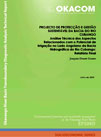Scientific studies aid Okavango Basin Planning
Media release, January 15th 2010
January 15th 2010. Planning
for use of water and natural resources in the Okavango River Basin -
shared by Angola, Namibia and Botswana - will receive substantial
support this year in the form of consolidated scientific evidence about
the condition of the river and its surroundings.
The Permanent Okavango River Basin Water Commission (OKACOM) Environmental Protection and Sustainable Management of the Okavango River Basin (EPSMO) Project, which has been gathering information about water flow, plants, animals and human activities in the river basin for the past two years, will finalise its transboundary diagnostic analysis (TDA) report in May. It will provide essential data to support decision making by the three countries. The Basin is unusual in that its waters and shores are relatively pristine, protected for many years by low human population pressures.
In its upper reaches, Angola’s long armed conflict restricted opportunities for development.
OKACOM designed the EPSMO Project to evaluate the condition of the river basin, to identify possible threats posed by increasing demands on the river’s benefits and to develop a program of policy, legal and institutional reforms-a Strategic Action Plan-to meet and manage these demands. The first step was the TDA.
Based on scientific analysis and expert opinion, the TDA aimed to anticipate environmental, social and economic impacts and the requisite policy and institutional challenges of flow regime change due to water resources developments in the basin such as abstractions, impounds, land use change or climate change. A multidisciplinary team of scientists from the University of Botswana’s Harry Oppenheimer Okavango Research centre (HOORC) in Maun, the Polytechnic of Namibia, Agostinho Neto University in Angola and the University of Cape Town (South Africa) produced specialist analyses of hydrology, hydraulics, channel form, water quality, vegetation, aquatic invertebrates, fish, birds, river-dependent terrestrial wildlife, resource economics and socio-cultural issues.
The resulting reports were then pulled together using a cutting-edge method called environmental flow analysis to build scenarios for future possible uses of the river system’s resources.
OKACOM’s commissioners will be able to use these scenarios to identify opportunities and concrete projects and programmes needed to balance the needs of conservation and development.
Next month, OKACOM will discuss implements of the study’s findings in a special panel session at the University of Botswana’ Flood Pulsed Wetlands International Symposium at the Harry Oppenheimer Okavango Research Centre in Maun, Botswana. The Commission will make the TDA report available following its annual meeting in May.
The Permanent Okavango River Basin Water Commission is an intergovernmental body set up in 1994 by the three countries sharing the basin. OKACOM’s mandate is to ensure equitable use and wise management of the river basin’s benefits.







 GEF IW:LEARN
GEF IW:LEARN